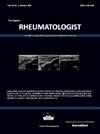Cardiovascular involvement in Behçet’s disease patients: Carotid atherosclerosis, neutrophil–lymphocyte ratio, platelet-lymphocyte ratio, and serum asymmetric dimethylarginine
IF 1
Q4 RHEUMATOLOGY
引用次数: 0
Abstract
Aim of the work
To assess the frequency of subclinical atherosclerosis in Behçet’s disease (BD) and the influence of neutrophil–lymphocyte ratio (NLR), platelet-lymphocyte ratio (PLR) and serum asymmetric dimethylarginine (ADMA) compared to traditional cardiovascular risk factors and their relation to the disease characteristics.
Patients and methods
This study included 60 BD patients and 30 age and sex matched healthy controls. The BD current activity form (BDCAF) was scored. Traditional cardiovascular risk factors were evaluated. Complete blood count was assessed and both NLR and PLR were calculated. Serum ADMA level was measured. Radiological evaluation of carotid intima media thickness (CIMT) was performed.
Results
The mean age of patients was 36.5 ± 10 years and were 48 males and 12 females (M:F 4:1). BD patients had significantly higher CIMT and carotid atherosclerotic plaques compared to the control (0.53 ± 0.14 versus 0.41 ± 0.09, p < 0.001 and 21.7 % versus 0 % respectively) despite similar rate of traditional cardiovascular risk factors. CIMT of BD patients correlated with age (r = 0.38,p = 0.003), disease duration (r = 0.3,p = 0.02), presence of ocular manifestation (r = 0.31,p = 0.02), waist/hip ratio (WHR)(r = 0.29,p = 0.03), NLR (r = 0.42, p = 0.001), PLR (r = 0.27, p = 0.04) and ADMA (r = 0.5,p < 0.001). Only serum ADMA level was found to be a significant determinant of CIMT in BD (p < 0.001), contributing in 37.9 % of the variance of CIMT. NLR, PLR and ADMA can differentiate BD with subclinical atherosclerosis at cut-off values 2.36, 125.51 and 1.27 umol/L respectively.
Conclusion
BD is associated with an increased rate of subclinical atherosclerosis, which is best determined by increased hematological indices and serum ADMA level rather than traditional cardiovascular risk factors.
behet病患者的心血管介入:颈动脉粥样硬化、中性粒细胞-淋巴细胞比率、血小板-淋巴细胞比率和血清不对称二甲基精氨酸
目的评价behet病(BD)亚临床动脉粥样硬化的发生频率、中性粒细胞-淋巴细胞比率(NLR)、血小板-淋巴细胞比率(PLR)和血清不对称二甲基精氨酸(ADMA)与传统心血管危险因素的比较及其与疾病特征的关系。患者和方法本研究包括60例BD患者和30例年龄和性别匹配的健康对照。对BD当前活动表(BDCAF)进行评分。评估传统的心血管危险因素。评估全血细胞计数,计算NLR和PLR。测定血清ADMA水平。影像学评估颈动脉内膜中膜厚度(CIMT)。结果患者平均年龄36.5±10岁,男48例,女12例(男∶女4:1)。与对照组相比,BD患者的CIMT和颈动脉粥样硬化斑块明显增加(0.53±0.14比0.41±0.09,p <;0.001和21.7%(分别为0%),尽管传统心血管危险因素的发生率相似。测量出的双相障碍患者与年龄相关(r = 0.38, p = 0.003),疾病持续时间(r = 0.3, p = 0.02),出现眼部表现(r = 0.31, p = 0.02),腰围/臀围(WHR) (r = 0.29, p = 0.03), NLR (r = 0.42, p = 0.001), PLR (r = 0.27, p = 0.04)和ADMA (r = 0.5, p & lt;0.001)。只有血清ADMA水平是BD患者CIMT的重要决定因素(p <;0.001),贡献了37.9%的CIMT方差。NLR、PLR和ADMA可以区分BD与亚临床动脉粥样硬化,临界值分别为2.36、125.51和1.27 umol/L。结论bd与亚临床动脉粥样硬化发生率升高相关,与血液学指标和血清ADMA水平升高有关,而不是传统的心血管危险因素。
本文章由计算机程序翻译,如有差异,请以英文原文为准。
求助全文
约1分钟内获得全文
求助全文

 求助内容:
求助内容: 应助结果提醒方式:
应助结果提醒方式:


